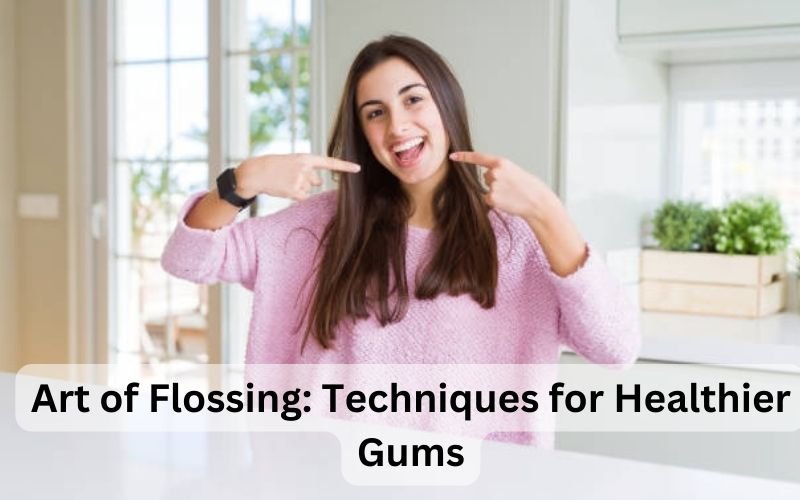Brushing your teeth has become a symbol of mastering a habit for most of us. However, brushing alone is not enough to remove food debris and bacteria from your teeth. As most dentists recommend, brushing and flossing are the most effective ways to prevent plaque formation. If you’ve made brushing your teeth a habit, it’s never too late to incorporate minty dental floss into your daily oral hygiene routine. In this post, we will share the effects of flossing on your oral health and how to floss properly without damaging your gums.
The Need to Clean Your Teeth

According to the World Health Organization (WHO) Global Oral Health Status Report, approximately 3.5 billion individuals worldwide are affected by oral diseases, with approximately three-quarters of those affected living in middle-income countries. Globally, approximately two billion humans are afflicted by dental caries in their permanent enamel, even as 514 million kids are afflicted by dental caries of their primary teeth, the document stated. Furthermore, WHO emphasized that a significant portion of oral health problems can be prevented through proactive measures and can be made more manageable if detected at an early stage.
When to Floss
We should make flossing a regular part of our daily dental care routine, just like brushing our teeth every day. It’s the best way to remove plaque from between your teeth and prevent gum disease and cavities. If plaque remains in these areas, it turns into tartar, which is even more challenging to remove.
Also Read – 10 Surprising Benefits of Clove Oil for Teeth That You Need to Know
How to Floss
Beyond just flossing, gaining knowledge of the suitable approach is crucial. If we do not comply with the proper method we can damage our teeth and gums. So here is a step-by-step manual to flossing your enamel successfully:
- Start with a piece of floss long enough to maintain securely. Typically, 12-18 inches of floss is ok.
- Wrap the floss across the palms or tie the ends to shape a loop.
- Pull the floss tightly between your thumb and forefinger.
- Then slide it slowly among the enamel, up and down, rubbing the surface of the enamel on each aspect.
- Be careful that the floss does now not touch your gums, as this may cause injury.
- Repeat this up-and-down movement 2 or three times.
- When the floss reaches the gums, lightly bend the floss to shape a ‘C’ around the teeth and skip it below the gums to clean the area between the gums and the tooth.
- Slowly circulate the floss to and fro, up and down, underneath the gum line without making use of an excessive amount of strain.
- Repeat those steps for the subsequent tooth until you’ve got addressed all of the enamel inside the mouth.
- If the floss turns torn or soiled, utilize a clean piece.
Benefits of Flossing
There are surfaces at the teeth that best a string of floss can attain. If performed daily, flossing is a powerful addiction a good way to provide the subsequent blessings:
Also Read – How to Cure Mouth Ulcers Fast and Naturally
Removes hidden food debris:
There are hard spaces among our teeth in which meals debris can get stuck. Although brushing and the use of toothpicks can cast off seen food debris, there will nonetheless be a few residues left in the gaps among your enamel. By flossing, you do now not depart any area for bacteria to grow in your tooth.
Prevents plaque formation:
Disease-causing bacteria that motivate tooth decay thrive inside the presence of starch and sugar. Flossing each day prevents bacteria from growing in plaque between your tooth and close to the gum line.
Keeps your breath fresh:
Have you ever wondered why your breath smells even after brushing your teeth? This scent comes from the presence of bacteria from plaque and food particles trapped in your mouth. Dental floss and mouthwash, in addition to brushing, are an effective mixture to keep your breath sparkling all day long.
Protects your gums from periodontal disease:
Dental floss gets rid of plaque that carries disorder-inflicting microorganisms. This prevents microorganisms from aggravating the gums, inflicting inflammation or gingivitis, and from getting into the bloodstream through the root of your enamel.
Prevents tooth decay and staining:
Food particles that remain among your enamel will increase the hazard unfavorable to your tooth teeth. The bacteria launch acids that weaken the tooth and form small cavities. With an everyday flossing routine, you reduce the chance of developing hidden cavities in your enamel, which could lead to enamel infections if left untreated.
How to floss your teeth properly
The ideal way to smooth your mouth is to floss earlier than brushing your teeth. Your dental floss will do away with bacteria and meal particles from among your teeth. If you sweep after flossing, the microorganism will remain in your mouth and continue to damage your tooth. If you constantly harm your gums whilst flossing, you will be doing it wrong. It is regular for gums to bleed inside the first few days. However, this ought to now not to be the case with day-by-day flossing. Here’s the precise technique for flossing your enamel.
- Cut the dental floss to at least 20 to 24 inches.
- Roll the ends of the floss over the index fingers of both your left and right hands and leave a few inches to floss your teeth.
- Hold the floss gently place it between your teeth and move the string in an up and down direction over the gums.
- Repeat the steps and use a new portion of floss for each tooth.
When plaque hardens on your teeth, it becomes tartar which requires the help of a dental professional to remove it.
Teeth Cleaning
Preventing any dental disease and keeping your teeth and gums healthy reduces the danger of any critical clinical conditions. By gaining knowledge of the addiction to flossing nowadays, your destiny self will thank you later. To bounce-start your new brush and floss routine, get your enamel and gums thoroughly wiped clean by a dental expert to get them begun again.
Conclusion
Good oral fitness is more than simply brushing. Flossing helps put off plaque and food from among your enamel and saves you from enamel decay and gum disorder. Flossing devices paintings just like conventional techniques using your arms. Practice flossing successfully to ensure that your enamel stays wholesome and delightful for years.

